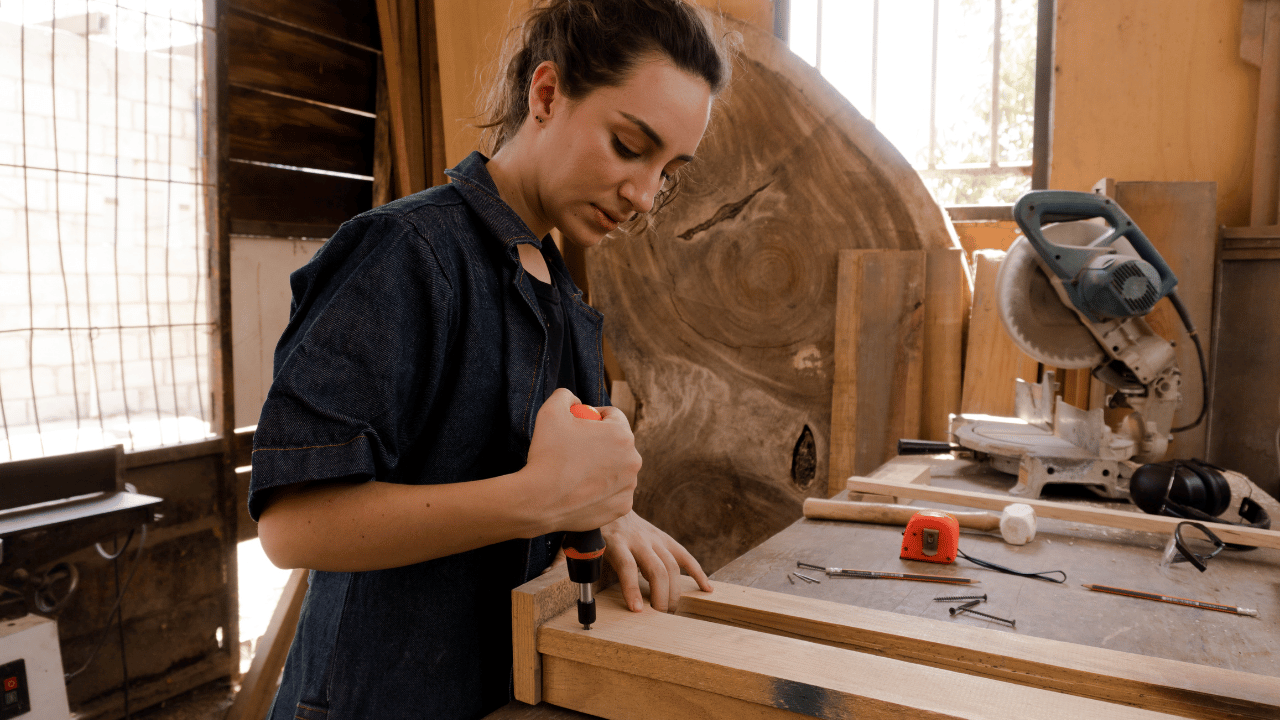Last Updated on October 21, 2023 by Pro Handyman Australia – Editorial Team
Carpenters exemplify the pinnacle of precision and performance in their work. Their remarkable versatility is evident in the diverse settings they operate in, from cozy residential spaces to vast industrial sites. Among the many questions they often encounter is, “can you cut metal with a miter saw?” This inquiry showcases the evolving demands and curiosities in the field of carpentry and construction.
Entering carpentry as an apprentice requires foundational skills. Much like seeking top carpenter handyman services, these basics ensure a successful start in this craft.
The Nature of Carpentry
Carpentry stands as a respected trade, with carpenters playing a pivotal role in numerous Beginner Carpentry Projects that primarily revolve around shaping, cutting, and installing a myriad of materials. Historically, carpenters primarily worked with wood. However, modern advancements have broadened the scope of carpentry, now encompassing materials like engineered lumber, metals, and prefabricated components. Today’s carpenters contribute to the creation of various structures such as ships, houses, bridges, and even complex concrete formworks. Some of their key responsibilities include setting up walls, ceilings, staircases, and beams.
Duties of a Carpenter

A carpenter’s role is multifaceted and may comprise the following tasks:
- Consulting and adhering to blueprints throughout the project.
- Crafting the fundamental frameworks of structures, which includes walls, floors, and ceilings.
- Installing essential fixtures, ranging from cabinets and windows to comprehensive furniture systems.
- Operating heavy machinery like cranes to facilitate their work.
- Skillfully cutting and molding a variety of materials.
- Ensuring that every aspect of their work complies with established codes and remains undamaged.
Specializations in Carpentry
As with many professions like Sydney handyman services, carpentry has its own set of specializations. Carpenters may focus their expertise in areas such as:
- Scenic carpentry, tailored for theatrical settings.
- Restoration and preservation carpentry, dedicated to bringing historical pieces back to life.
- Residential, industrial, and commercial carpentry, each pertaining to distinct settings.
- Log building for those passionate about wooden homes.
- Cabinetry, trim work, and joinery (or finish carpentry), each emphasizing a unique aspect of woodwork.
Skills Every Carpenter Should Possess

For a carpenter to thrive in their profession, they must hone a range of skills:
Mathematical Proficiency: Carpenters lean heavily on algebra and geometry to ascertain precise measurements, ensuring projects remain within budget.
Physical Robustness: Their workday often involves lifting heavy materials, using an array of tools, and enduring prolonged periods of standing, bending, or climbing.
Effective Communication: Being part of larger teams or dealing directly with clients necessitates clear communication—be it verbal, written, or through active listening.
Unwavering Attention to Detail: Precision is paramount in carpentry. Carpenters meticulously follow blueprints to ensure structures align with the specified designs, thereby conserving both time and resources.
Problem-solving Prowess: Carpentry isn’t without its challenges. From repairs to unforeseen complications, a solution-focused mindset is indispensable.
Dexterity: Handling intricate components demands agility and precision in hand movements.
Mechanical Acumen: Familiarity with a wide array of machinery, from power saws to drills, not only facilitates a carpenter’s tasks but also enhances their versatility in the job market.

Perfecting Straight Cuts
Carpenters, owing to their training, are adept at executing a myriad of cuts, both simple and intricate. Interestingly, mastering straight cuts can pose challenges even for them. Introductory woodworking courses, like the Certificate III in carpentry, prioritize instilling this foundational skill. Familiarizing oneself with this technique ensures a steady hand on the lumber, facilitating the handling of larger pieces. There’s no dearth of tools in the market to achieve these pristine cuts: from miter saws and power saws to traditional hand saws. Mastery over these instruments translates to cutting with remarkable precision.
The Art of Wood Drilling
While drilling wood might seem rudimentary, the reality is quite the contrary. Managing the cordless drill‘s heft while ensuring uniformity in the holes is not an easy feat for novices. Carpenters often need to drill holes of varying sizes and depths based on project specifications.
Only a carpenter with comprehensive training can drill flawlessly, circumventing potential flaws. Therefore, familiarizing oneself with drilling fundamentals is paramount, especially if you aim to craft furniture pieces like chairs or bookshelves.
Harnessing the Power of Saws
A carpenter’s arsenal is incomplete without various types of power saws, each tailored for specific tasks. Their utility spans across complex projects to DIY endeavors. For tasks like trimming and lumbering, saws prove indispensable.
Practice remains the key to mastery. Utilize the circular saw for extended cuts, and for crafting intricate patterns, the jigsaw emerges as the tool of choice.
Practice remains the key to mastery. Utilize the circular saw for extended cuts, and when crafting intricate patterns, having a good understanding of jigsaw blades becomes essential as the jigsaw emerges as the tool of choice.
The Nuance of Nail Hammering
Hammering nails might seem mundane, but its significance in carpentry is paramount. Mastering this elemental skill ensures not only a refined finish but also structural integrity.
Key construction endeavors, be it framing walls, crafting roofs, or building decks, hinge on proficient nail hammering. While traditional hammers remain popular, innovative tools like pneumatic nail guns and palm nailers can expedite the process, melding efficiency with finesse.
Angles and Joinery: The Backbone of Precision
Beyond measurements, a carpenter’s grasp of angles and joinery dictates the aesthetics and accuracy of their wooden creations. Executing compound angles with meticulous joinery emerges as a quintessential skill for top-tier carpenters.
It’s not merely about visual appeal; ensuring correct angles guarantees wooden structures that are robust, balanced, and seamlessly aligned, prepared to withstand the rigors of time.

Crafting Level and Plumb Surfaces
Throughout their careers, carpenters encounter myriad projects necessitating the crafting of both level and plumb surfaces, be it in grand edifices like bridges or everyday items like furniture.
Achieving level surfaces typically revolves around the right angles and measurements. Plumb surfaces, on the other hand, demand the meticulous establishment of a level line. A seasoned carpenter seamlessly fuses both, delivering outputs marked by efficiency and top-tier quality.
Mastering the Art of Measurement
Precision is a carpenter’s best friend. One foundational skill every carpenter needs to hone is the art of measurement. Familiarize yourself with tools like metal squares or tape measures. A pro-tip: stick to one measuring tool throughout a project. This ensures consistency and prevents discrepancies that might arise from using different tools.
Understanding Wood Grain
The very essence of carpentry is in understanding wood. A key aspect of this is recognizing and respecting the wood grain. Always ensure that you cut and sand in the direction of the grain. Adhering to this principle guarantees smoother finishes and minimizes unwanted tear-outs.
Broadening Tool Expertise
Carpentry is as much about skills as it is about tools. Diverse projects require an array of tools, from miter saws and sanders to chisels. Investing time in practicing with these tools will not only enhance your skill set but also ensure you’re well-equipped for any project thrown your way.
Showcasing Your Carpentry Prowess

Crafting a Stellar Resume
When piecing together your resume, carve out a dedicated section for your carpentry skills. Ensure this section mirrors the requirements of the job you’re vying for. While listing down skills is essential, take it a step further by complementing each skill with an anecdote or example from your experience. Moreover, integrate these skills seamlessly into your work history, giving potential employers a holistic view of your capabilities.
Penning a Persuasive Cover Letter
Your cover letter is a window to your passion and proficiency. Dive deep into two or three carpentry skills that resonate most with the job description. Narrate instances where you’ve applied these skills, painting a vivid picture for the hiring manager. And remember, brevity is key. Ensure your cover letter is concise, compelling, and devoid of errors.
Nailing the Job Interview
The interview arena is where you bring your resume and cover letter to life. Delve into the carpentry skills most pertinent to the role you’re applying for. Offer insights, experiences, and maybe even a story or two that underscores your expertise. A bit of preparation can go a long way. Before you step into that interview room, rehearse how you’d articulate your skills, ensuring you present yourself confidently and convincingly.
Additional Essential Techniques for Every Woodworker: Honing the Core of Craftsmanship
Woodworking, an art as old as civilization itself, is a tapestry woven with myriad techniques. Mastering these foundational techniques not only defines the quality and beauty of the end product but also influences the journey of creation. Let’s dive deep into the significance of understanding and mastering these essential woodworking techniques.

1. Laying the Foundation for Excellence
Understanding the Basics
Every grand structure is built on a strong foundation, and the same holds true for woodworking. Learning the fundamental techniques ensures that a woodworker is well-equipped to handle various challenges and create items that are both functional and aesthetically pleasing.
2. Enhancing Precision and Accuracy
Measure Twice, Cut Once
One of the age-old adages in woodworking, this saying emphasizes the importance of accuracy. Knowing the right techniques to measure, mark, and make precise cuts can mean the difference between a masterpiece and a piece riddled with mistakes.
3. Safety First
Protecting Yourself and Your Workspace
Essential woodworking techniques often encompass best practices for safety. Understanding how to correctly use tools, maintain them, and work with different wood types minimizes the risk of accidents, ensuring a safe and productive working environment.
4. Time Efficiency and Productivity
Streamlining the Process
By mastering core techniques, a woodworker can execute projects more efficiently. Time is saved when one knows the quickest and most effective way to complete a task without compromising on quality.
5. Versatility in Projects
Adapting to Various Designs
Different projects demand different techniques. A comprehensive understanding of essential woodworking methods allows craftsmen to work on a diverse range of projects, from intricate furniture designs to robust outdoor setups.
6. Material Conservation
Maximizing Wood Usage
Wood, especially premium varieties, can be expensive. By knowing how to correctly measure, cut, join, and finish, wastage is minimized, ensuring that every bit of material is utilized to its maximum potential.
7. Building Professional Credibility
Craftsmanship That Stands Out
A woodworker’s prowess is often judged by the finesse of their work. Mastery over essential techniques is a testament to their commitment to the craft, helping them stand out in a competitive market and attract discerning clientele.
8. Continuous Learning and Upgradation
Staying Updated with Evolving Techniques
Woodworking, though rooted in tradition, is continually evolving. By understanding the basics, a woodworker is better positioned to adapt to new methods, tools, and technologies, ensuring their skills remain relevant and in-demand.
9. Repair and Restoration Skills
Breathing Life into Old Pieces
Many woodworking enthusiasts and professionals often find themselves working on restoration projects. Knowing the essential techniques enables them to accurately assess damages, identify original construction methods, and seamlessly restore vintage pieces to their former glory.
10. Enhancing Creative Expression
Marrying Imagination with Technique
While creativity is the soul of any woodwork, techniques are the hands that shape it. By mastering the necessary methods, woodworkers can more effectively bring their visions to life, creating pieces that resonate with both the creator and the beholder.
11. Cost Efficiency
Doing More with Less
Mastering essential techniques often translates to reduced reliance on outsourcing certain tasks or purchasing specialized tools. This self-reliance can lead to significant cost savings over time, especially for professional woodworkers.
In the world of woodworking, techniques are the unsung heroes. They shape, define, refine, and bring to life the dreams and designs of the artisan. Understanding and mastering these essential woodworking techniques is more than just a skill acquisition; it’s a journey towards perfection, safety, and self-expression. Whether a novice or a seasoned pro, there’s always a technique waiting to be mastered, promising to elevate the craft to new heights.
Mastering the Craft: The Advantages of Knowing Essential Techniques for Every Woodworker
Woodworking is a timeless art, rich with tradition, yet ever-evolving. For anyone aspiring to achieve mastery in this domain, understanding essential techniques is not just beneficial but paramount. Let’s delve into the manifold advantages of arming oneself with these foundational woodworking techniques.

1. Crafting with Confidence
Elevating Self-assurance in Every Project
Possessing a grasp on essential techniques imparts a profound sense of confidence. This confidence translates into more ambitious projects, bolder designs, and a willingness to push the boundaries of one’s creativity.
2. Aesthetic and Functional Superiority
Perfecting the Balance between Beauty and Utility
Knowledge of the right techniques ensures that the finished product doesn’t just look good but also serves its purpose efficiently. From ensuring snug fits in joinery to achieving the perfect finish, these techniques elevate both the form and function of the project.
3. Safety and Well-being
Navigating the Workshop without Worry
Many essential woodworking techniques are centered around safety. By understanding the correct way to use tools, handle materials, and set up one’s workspace, the risk of accidents is significantly diminished, making the woodworking journey safer and more enjoyable.
4. Optimized Time Management
Achieving More in Less Time
Efficiency is a prized attribute in any craft. A solid foundation in core techniques means less time deciphering how to achieve certain effects or finishes and more time spent creating and perfecting. This streamlined process can drastically reduce project timelines.
5. Resource Conservation and Sustainability
Reducing Wastage, Maximizing Value
Accurate measuring, cutting, and finishing techniques ensure optimal use of materials. This conservation approach not only reduces costs but also promotes sustainable practices by minimizing waste.
6. Boosting Professional Prospects
Setting a Higher Standard
For those in the commercial woodworking realm, technical expertise can significantly boost professional credibility. Clients and customers are more likely to trust and invest in a woodworker who showcases mastery in essential techniques.
7. Versatility in Crafting
From Minimalist Designs to Grand Constructions
A comprehensive understanding of essential techniques prepares a woodworker to tackle varied projects with equal aplomb. Be it crafting a delicate jewelry box or constructing a sturdy bookshelf, the ability to adapt and apply techniques as required is invaluable.
8. Financial Savings
DIY Repairs and Customizations
With a solid grasp of woodworking techniques, the need to hire professionals for repairs or modifications diminishes. Over time, this DIY approach can lead to significant cost savings.
9. Continuous Learning and Growth
Laying the Groundwork for Advanced Techniques
Foundational techniques form the base upon which more advanced methods are built. A strong grounding ensures that as the craft evolves and new techniques emerge, the woodworker can integrate them with ease, ensuring perpetual growth.
10. Enhanced Problem-Solving Skills
Navigating Challenges with Technical Know-How
In woodworking, unforeseen challenges are a given. However, with a deep-seated understanding of essential techniques, problem-solving becomes intuitive. Technical know-how often provides multiple solutions to a single challenge, fostering innovation.
11. The Joy of Mastery
Finding Fulfillment in the Journey of Learning
There’s an unparalleled satisfaction in mastering a technique, in witnessing raw materials transform under one’s fingertips into functional art. This joy, intrinsic to the journey of learning and mastery, is in itself a significant advantage.
The world of woodworking is vast, intricate, and endlessly rewarding. For those who invest the time and effort into truly understanding its essential techniques, the rewards are manifold. From tangible benefits like safety, cost savings, and professional growth to the intangible joys of creativity, mastery, and fulfillment, the advantages of knowing essential woodworking techniques are both profound and far-reaching. For every woodworker, from the amateur to the maestro, this knowledge isn’t just power—it’s the very soul of the craft.
Conclusion

In the intricate world of carpentry, skills are the pillars that uphold craftsmanship, innovation, and safety. A well-rounded carpentry skills checklist is not merely a list but a testament to the carpenter’s dedication to mastering their trade. From understanding wood grain to mastering advanced tools, every skill amplifies the quality of work and the efficiency of the task at hand. Whether you’re a budding carpenter or a seasoned artisan, revisiting and expanding upon this checklist ensures that your work remains at the pinnacle of precision and excellence. In essence, the art of carpentry is an ever-evolving journey, and a comprehensive skills checklist is the roadmap guiding every craftsman towards unparalleled success.
